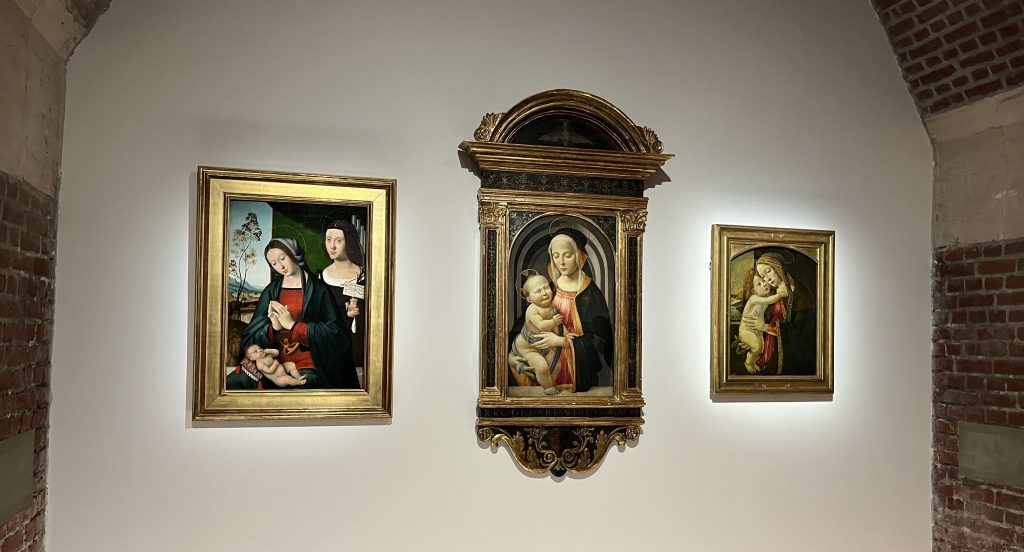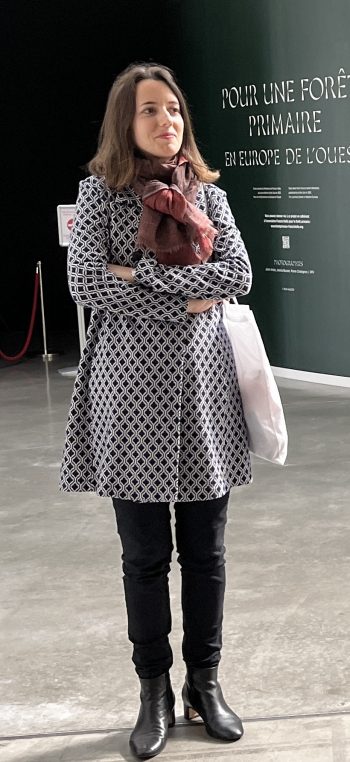
Francisco de Goya y Lucientes, “Time or the Old”, 1808-1812, “The letter, the Young”, ca 1814-1819, former collection of King Louis Philippe
Like many provincial French cities, Lille has a fabulous Arts Museum where Goya rivals with Rubens on the first floor. But what attracted us this week is the reopening of the Medieval and Renaissance galleries down below, which are brilliantly settled in the arched brick cellars. Sophie Duteilhet de Lamothe, the 36 year old curator took us around with grace and knowledge while her colleague Régis Cotentin, in charge of contemporary art, pointed out the discrete but efficient installations and videos set out in the whole museum. These treasures are well worth a visit to the North of France which counts many more exceptional museums in Cassel and Saint Omer.

John Isaacs, The architecture of empathy, (inspired by Michelangelo’s Pietà), Carrara marble, 2014, private collection
The original galleries in brick give a very modern look to the pieces of religious art (85% of the collection) which are among the most precious in France after Dijon, Autun, Toulouse and musée de Cluny of course. The chefs d’oeuvre are Donatello‘s sculpture of “Herode’s feast” in Carrara marble (well explained through a high resolution video presentation) and Dirk Bouts‘ “the Ascension of the Chosen” and “the Fall of the Damned” but also six reliquaries, and innumerable Flemish paintings. Lille is so close to Belgium and the Netherlands that its collections, acquired mostly in the 19 th century through gifts, are very influenced by the North.
An altarpiece of St George slaying the dragon made in Tyrol, ca 1480-1490, is confronted with a film of the Game of Thrones, many wooden statues of the Virgin Mary, a ravishing 1450 silk embroidered cloth representing the Annunciation, a 16 th century painting of “A meal at Simon’s” with Marie Madeleine kissing Christ’s feet under the table: all items are fascinating and prominently shown. The lighting of the galleries was entirely reimagined by Alexis Coussement for ACL and the lively scenography was conceived by Scénografiá. And the challenge of getting all kinds of public interested in Christian art is won.
The first room is spectacular with a group of Christs on the cross set on a “paradise” blue wall. It gives a theatrical look to the sculptures, one feels already in heaven. The story of Christ’s life is told chronologically and illustrated by admirable works which come mostly from Brussels and Antwerp in 1500. Since the public is very young, with many school children and students, the cartels are specifically well documented (and includes texts written by young trainees) and a great effort was made to attract the visitor’s eye and mind.
Because the curator previously taught Italian in schools, she knows how to entice children’s minds and she was particularly interesting when discussing the border between Medieval times and Renaissance. While in France, King François I marks the beginning of the Renaissance in the XVI th century, in Italy it starts with the Medici at the beginning of the XV th century .
She became an art historian through her love for Italy and presented her doctorate last year on the theme of “The body in individual prayer among the first Dominicans”. In parallel to the galleries, many works have been restored and the process is well explained on the cartels. Majolicas and plates by Francesco Della Robbia have been moved from the ceramics department upstairs and illustrate well the 15 th and 16 th century with the wooden sculptures and paintings, so that all the art of the period is exhibited in the same rooms. The atmosphere is so happy and light, thanks to an excellent scenography, and the diversity of pieces so great that one falls in love with these religious works which could otherwise seem austere.

Domenico Panetti, ca 1460, Bartolomeo Di Giovanni, 1501, School of Sandro Botticelli, end of 15 th century, Madonna and Child
Some pieces are on long loans from other museums like Ecouen and Valenciennes and from private collectors and a new major painting was acquired by the city of Lille last year at auction, “Ecce Homo” by the Master of Solomon’s triptych. The museum is municipal. A fun cinematographic fresco realized by Andy Guérif in 2015-2022, representing the passion of Christ by Duccio, is also exhibited. Three triptychs are shown together, one of the Virgin with child surrounded by musician angels, 1490, one of the Mystical bath, 1510-1520, and the Adoration of the Kings dated 1520 with an explanation by the conservators.

Master of 1518 (Jan Van Dornincke?) Triptych of the adoration of the Kings, the date of 1620 was uncovered during restoration
In the Main Hall of the 1892 museum, the exhibition “The Magical forest“, curated by Bruno Girveau and Régis Cotentin, shows many representations by painters and video artists. Based on Francis Hallé, the botanist who is fighting for restoring the primary forest in Western Europe, it exhibits, trees, haunted and enchanted forests, and sacred wood. from John Constable and Gustave Moreau to Brueghel and Mat Collishaw, the power of trees is beautifully illustrated.

Maximilian Lenz, Painter Friedrich König and Ida Kuperlwieser in a forest, ca 1910, Paris Musée d’Orsay
“La Forêt Magique” at Palais des Beaux Arts de Lille until September 19 and the reopening of the Medieval and Renaissance galleries is permanent. Lille is a hub for arts exhibitions. You can visit la Villa Cavrois, la Piscine in Roubaix (accessible by tube) and the LAM in Villeneuve d’Ascq and le Tripostal with the Fondation Cartier in Lille.
Share this Post





2 Comments on “In Lille, the museum is in full Renaissance”
Merci chère Laure pour ce magnifique article sur la réouverture du Département du Palais des Beaux Arts de Lille, tout l’équipe du musée est très émue !
Belle incitation, as usual. Merci Laure. We’ll see when I’ll be able to make it ?